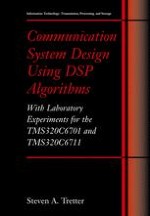2003 | OriginalPaper | Chapter
Echo Cancellation for Full-Duplex Modems
Author : Steven A. Tretter
Published in: Communication System Design Using DSP Algorithms
Publisher: Springer US
Included in: Professional Book Archive
Activate our intelligent search to find suitable subject content or patents.
Select sections of text to find matching patents with Artificial Intelligence. powered by
Select sections of text to find additional relevant content using AI-assisted search. powered by
An important advance in the design of high speed voice-band telephone line modems for the dial network was the introduction of echo cancelers to achieve full-duplex data transmission over 2-wire circuits. This technique was studied in the early 1980’s and then widely introduced in commercial products in the mid 1980’s when the CCITT V.32 recommendation for a 9600 bps modem was approved. A few years later, the V.32bis recommendation for 14.4 kbps modems was approved, and the V.34 recommendation for rates up to 33.6 kbps was approved in June 1994. These also use echo cancelers. The recent V.90 and V.92 modems that use PCM downstream use echo cancelers to. Echo cancelers are also used in some high speed digital subscriber lines at data rates of 64 kbps or more. Line echo cancelers were used with analog voice transmission to eliminate annoying talker echo prior to the inclusion of echo cancellation in digital data modems. The voice echo cancelers are placed at different points in the telephone circuit than the ones for data transmission and are disabled during data transmission by a special signal in the modem handshake sequence. The technique is also used in speaker phones to eliminate annoying acoustic reflections from the speaker to the microphone and then back to the far end talker.
